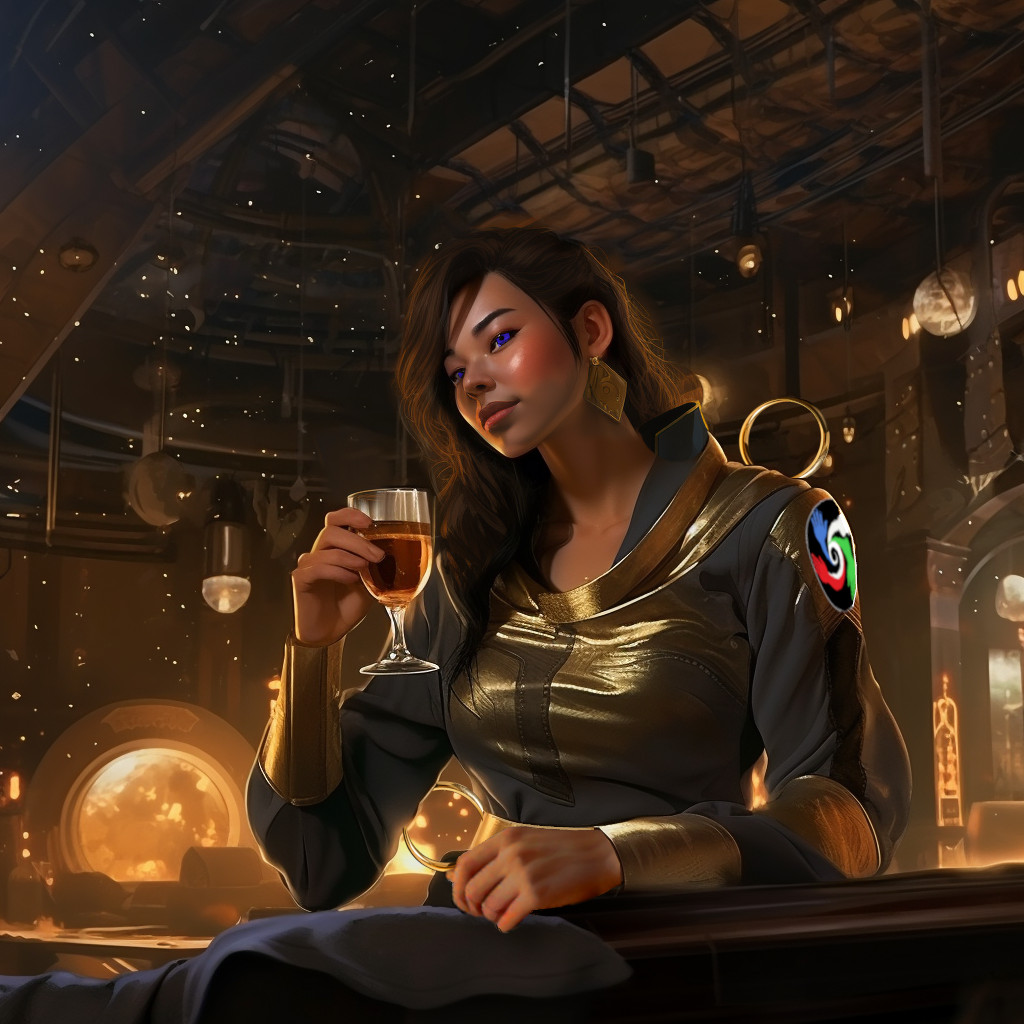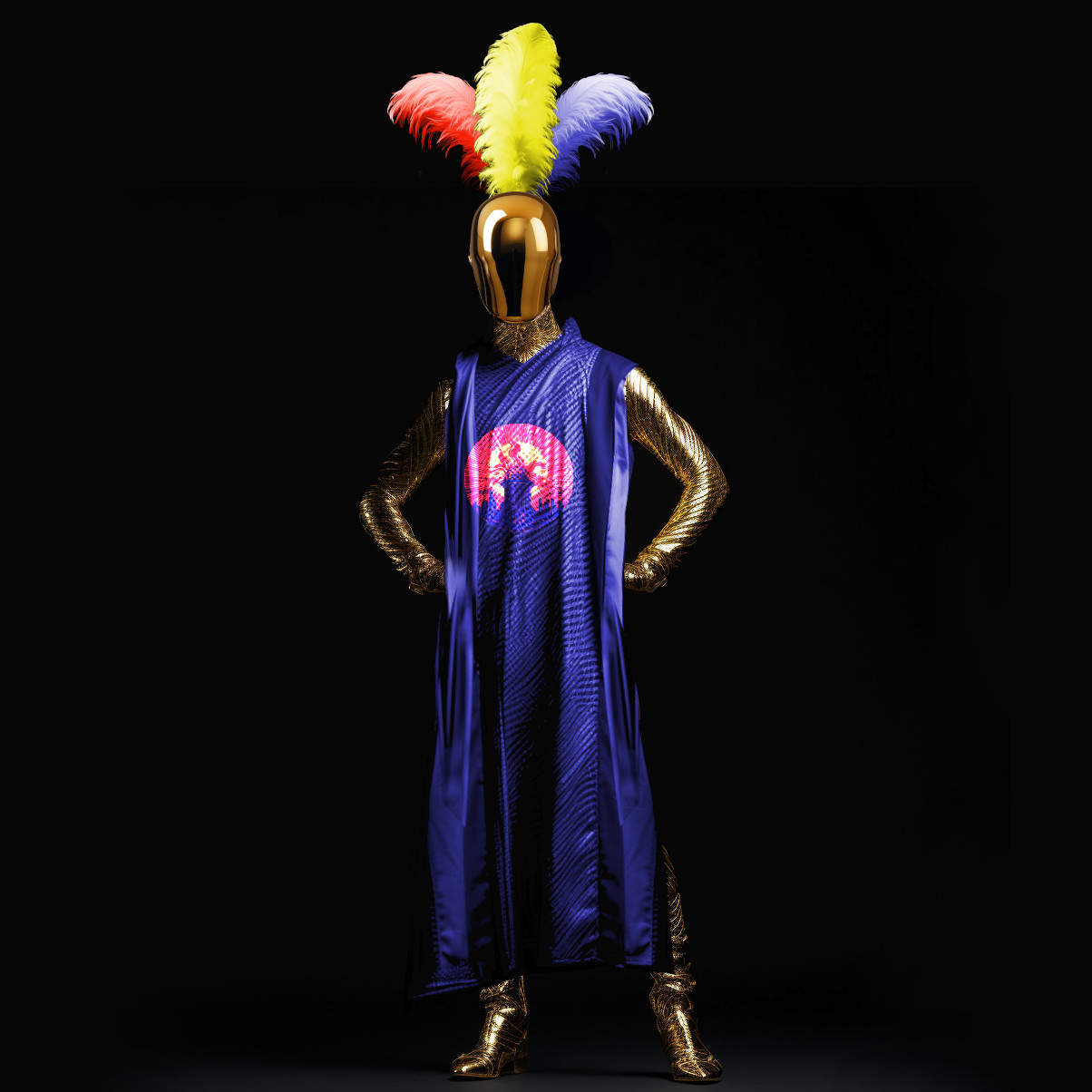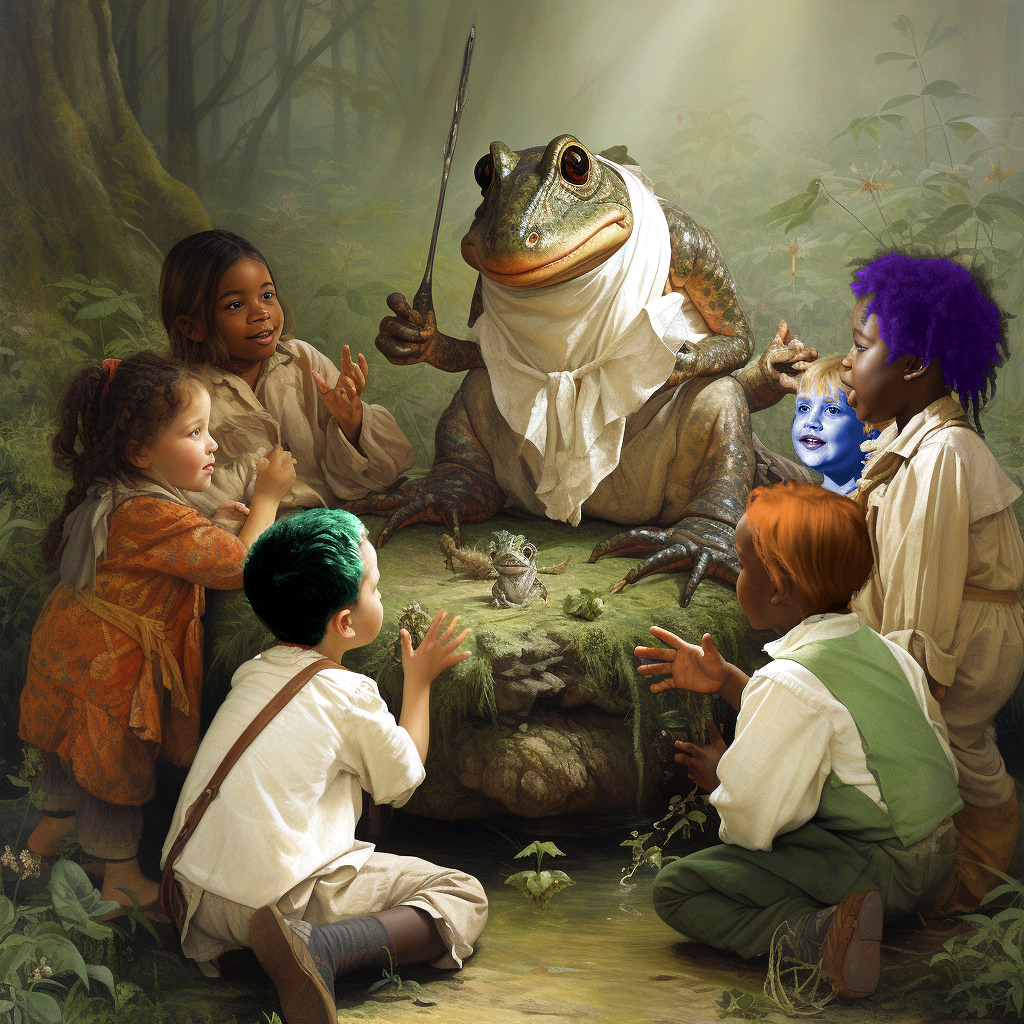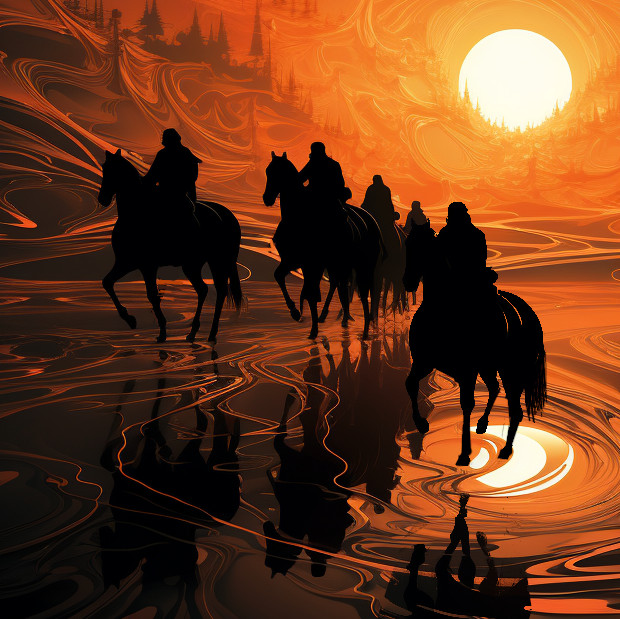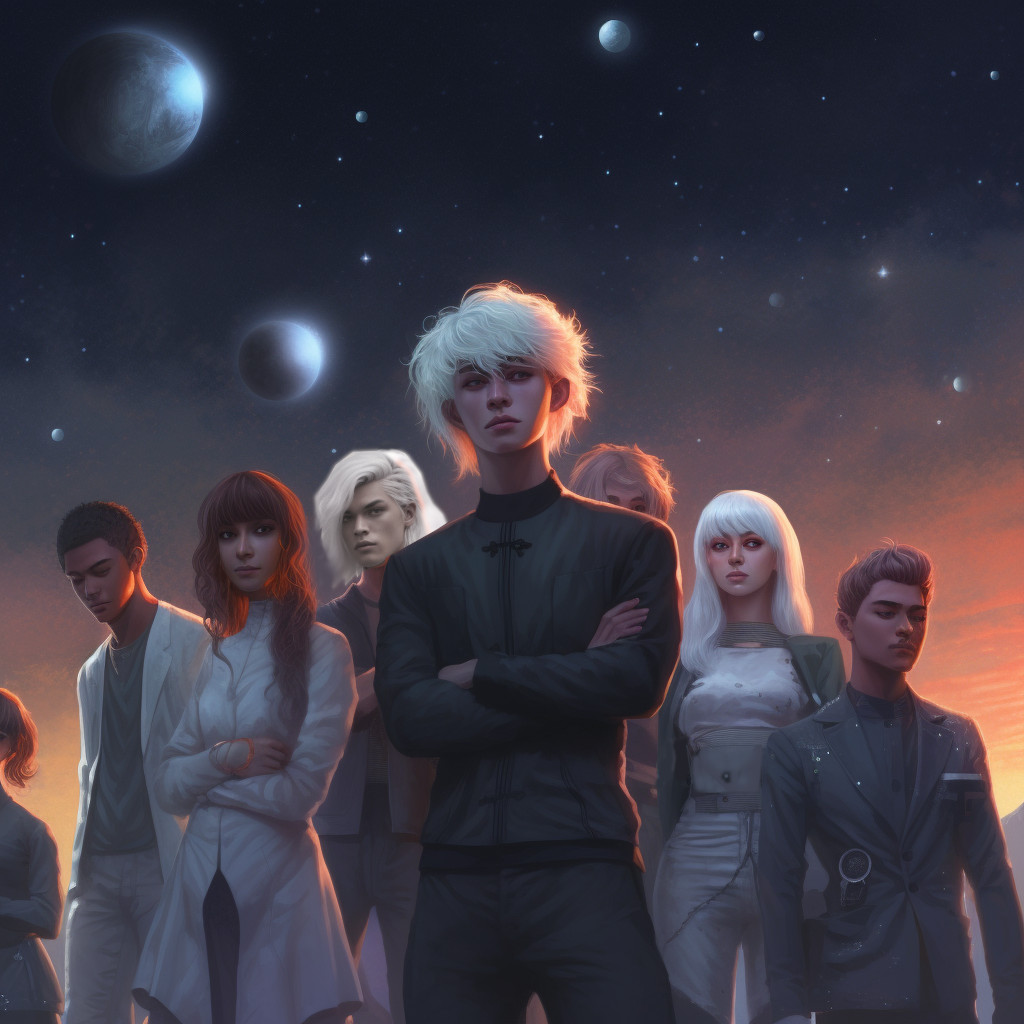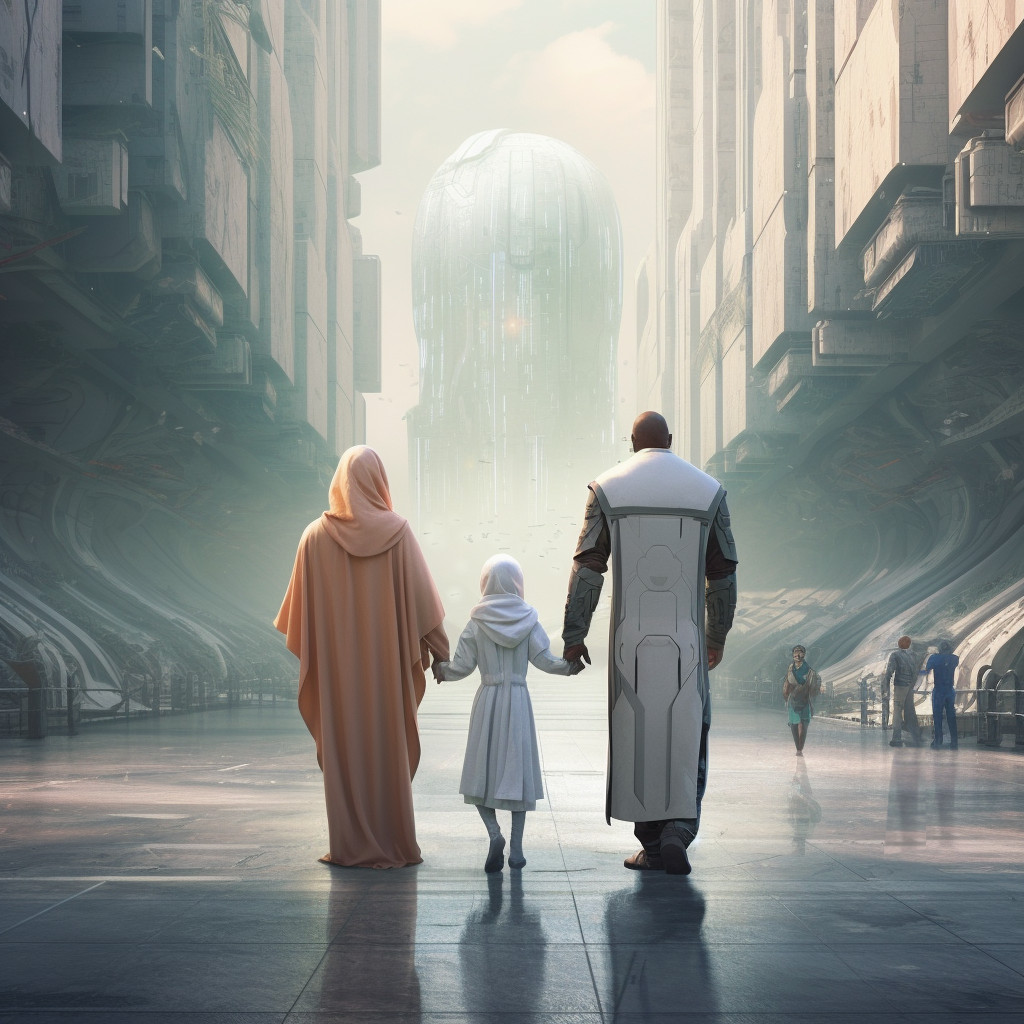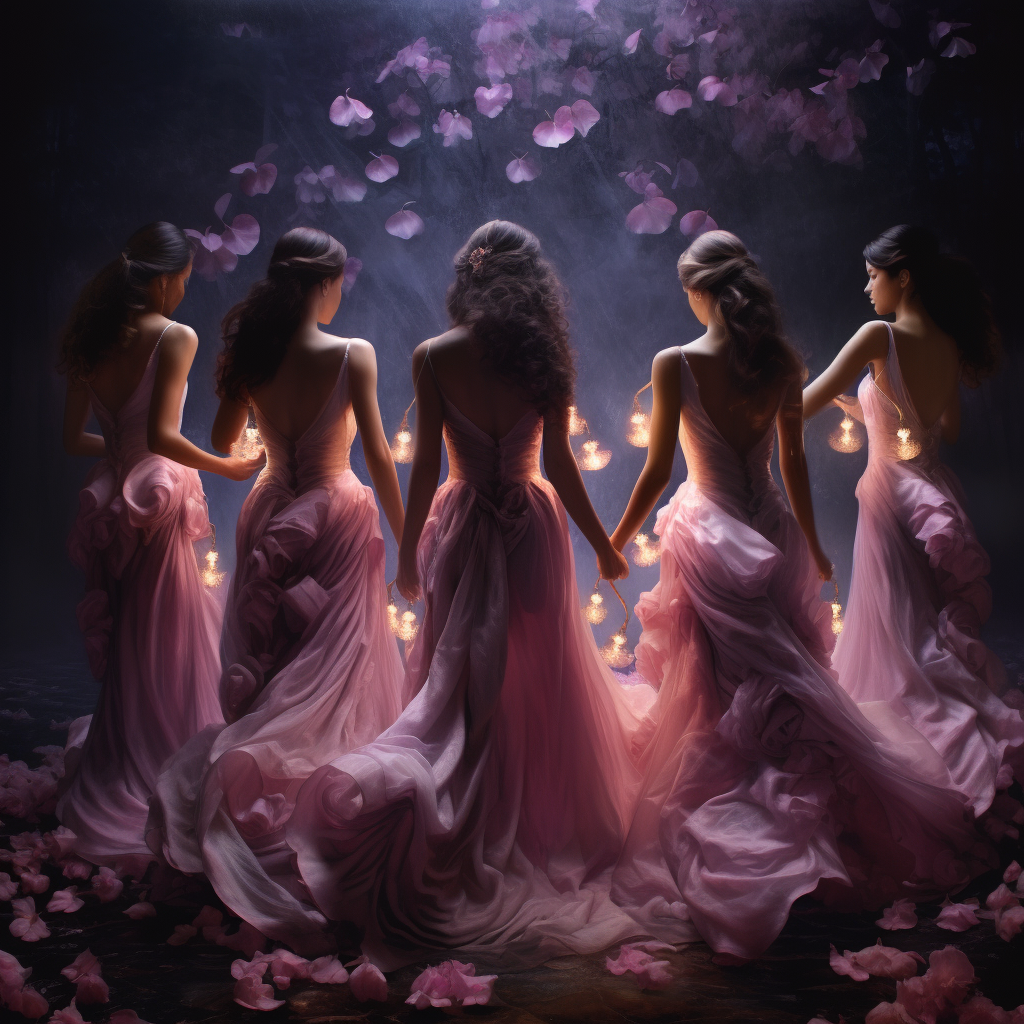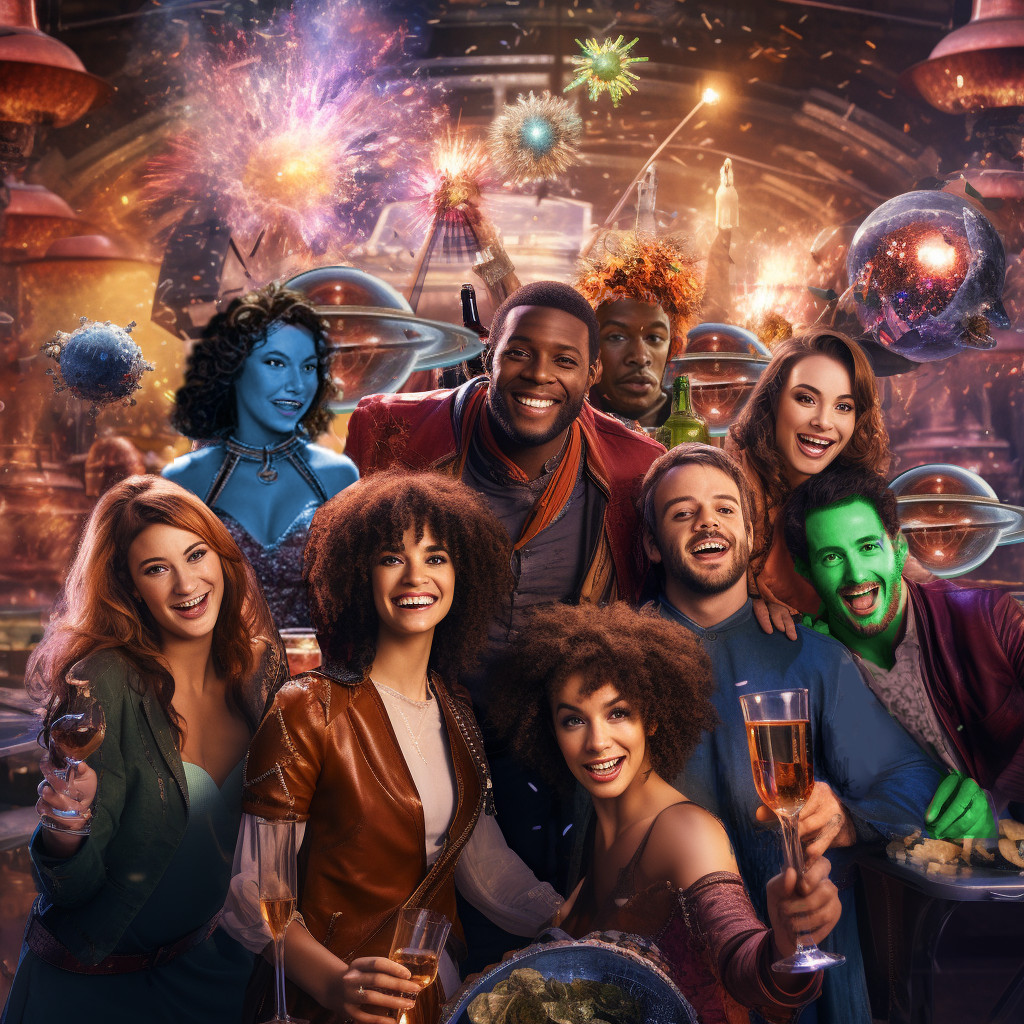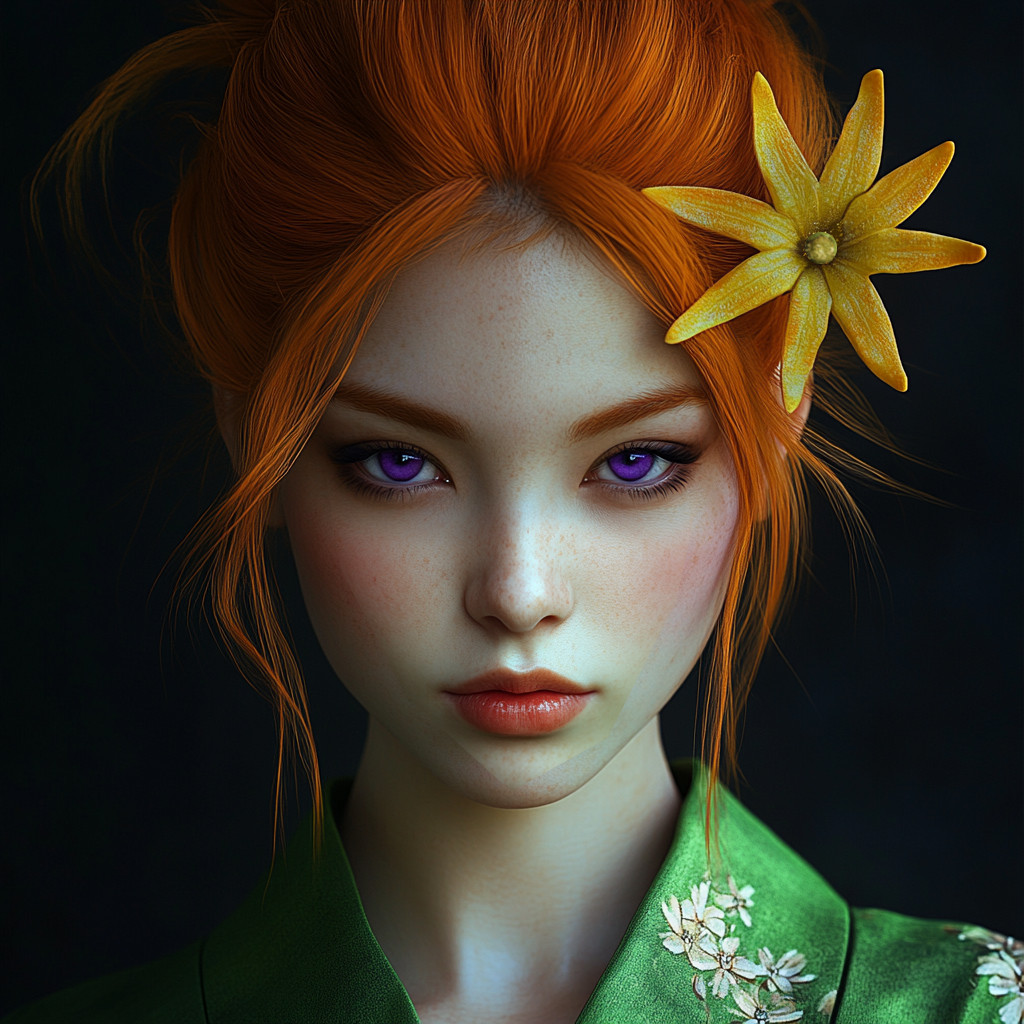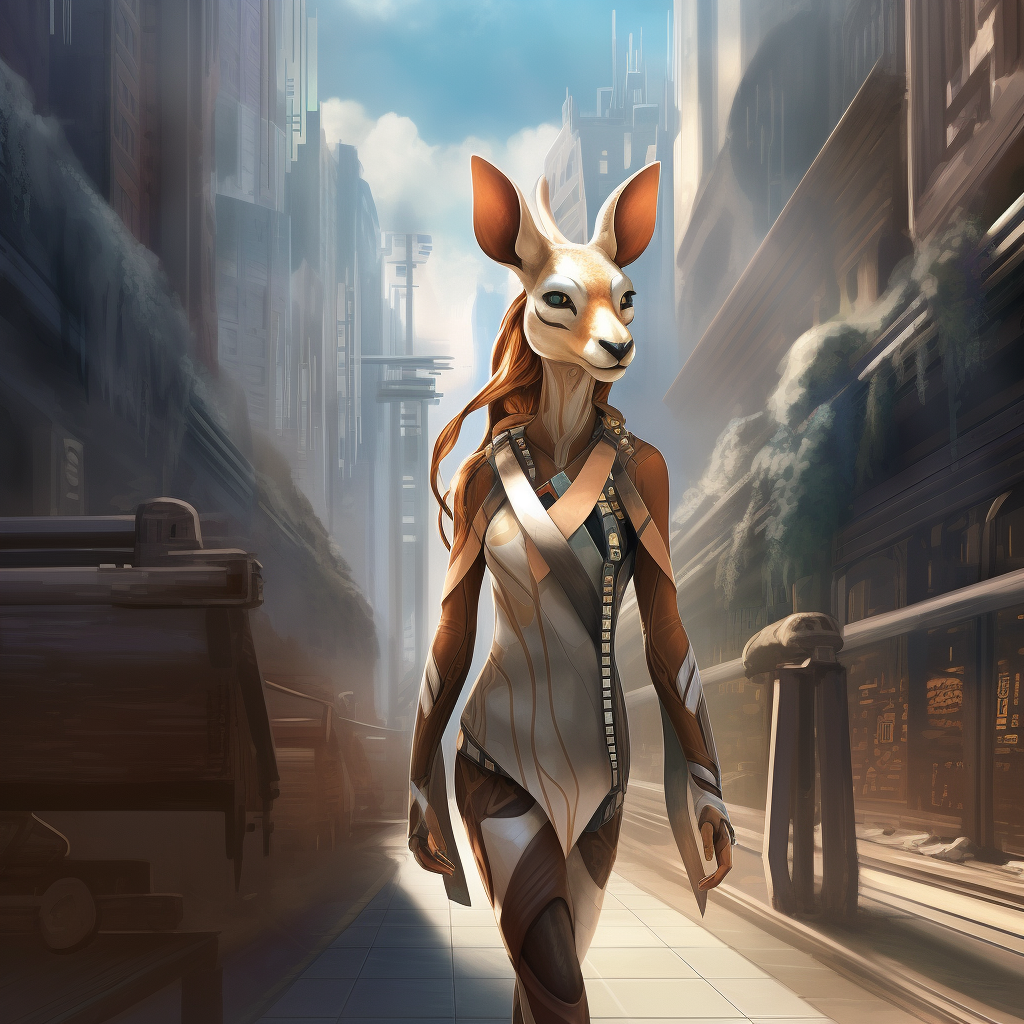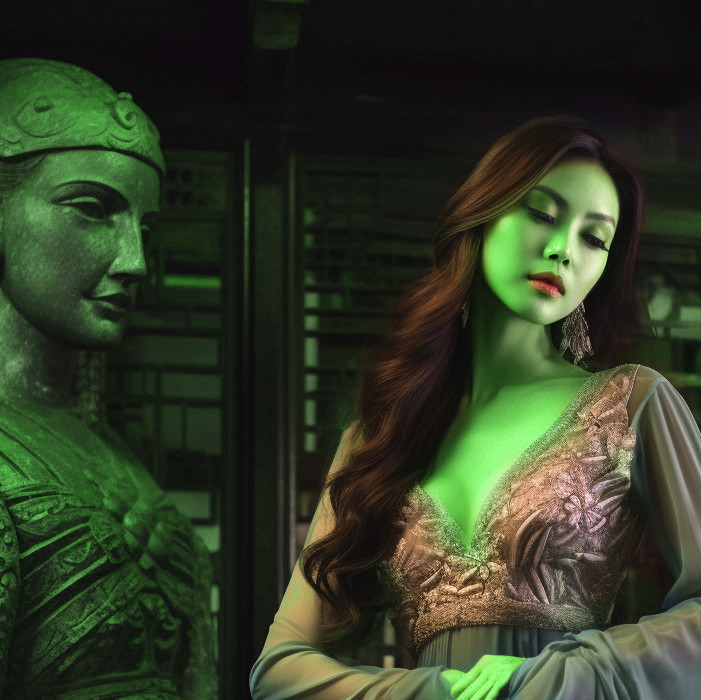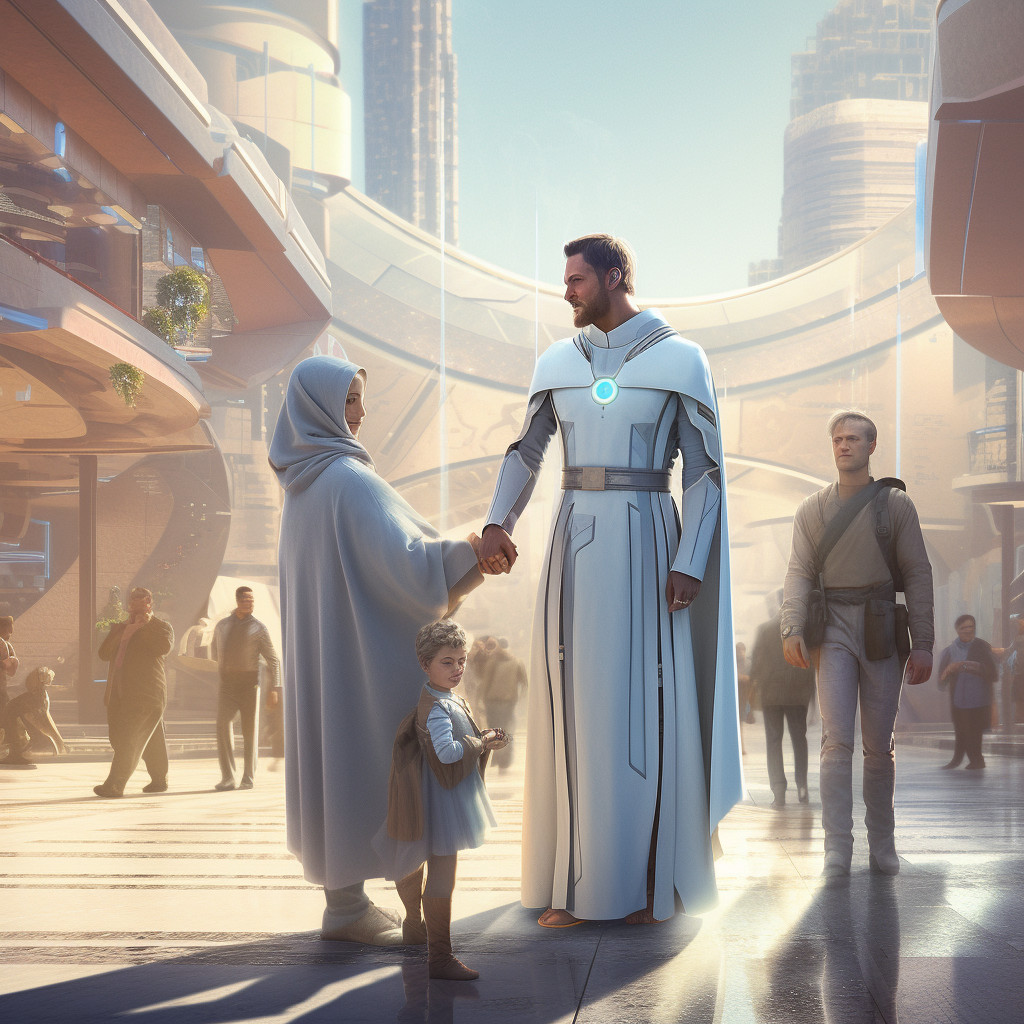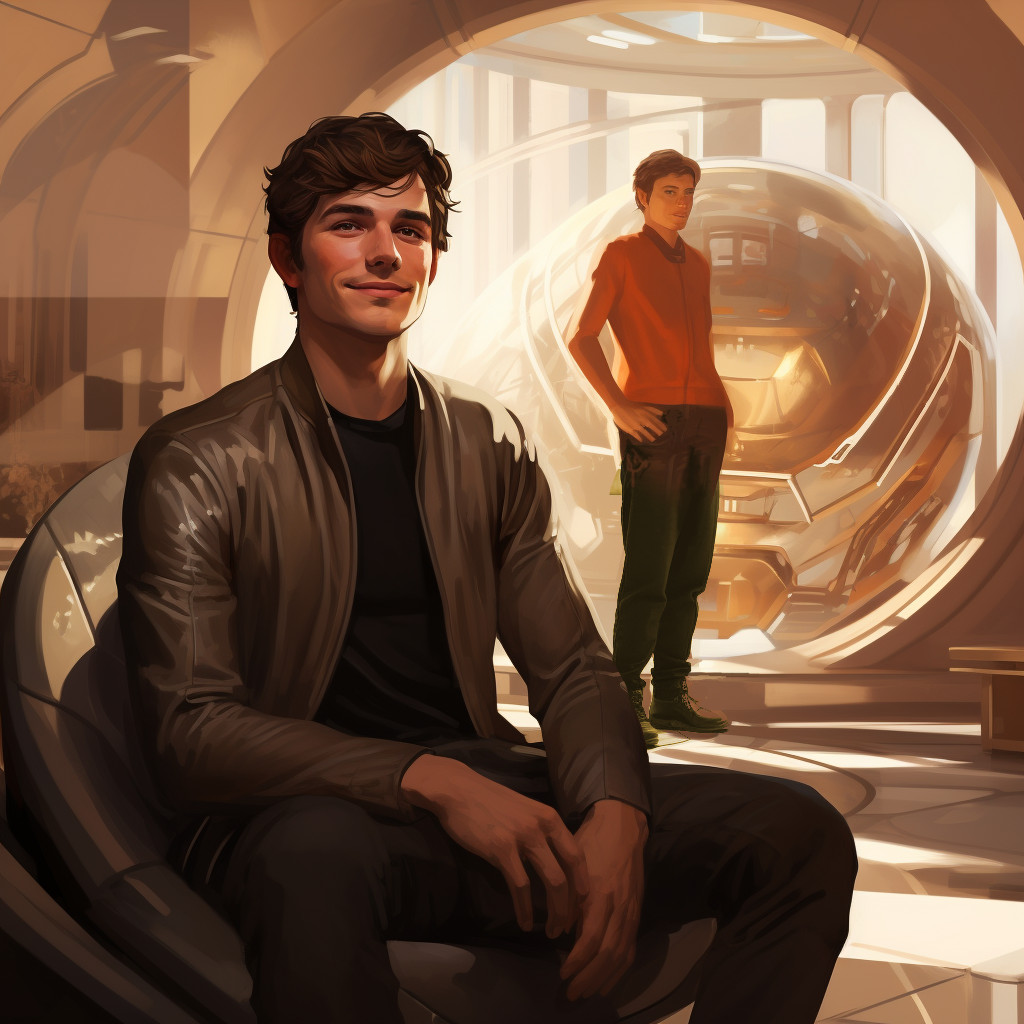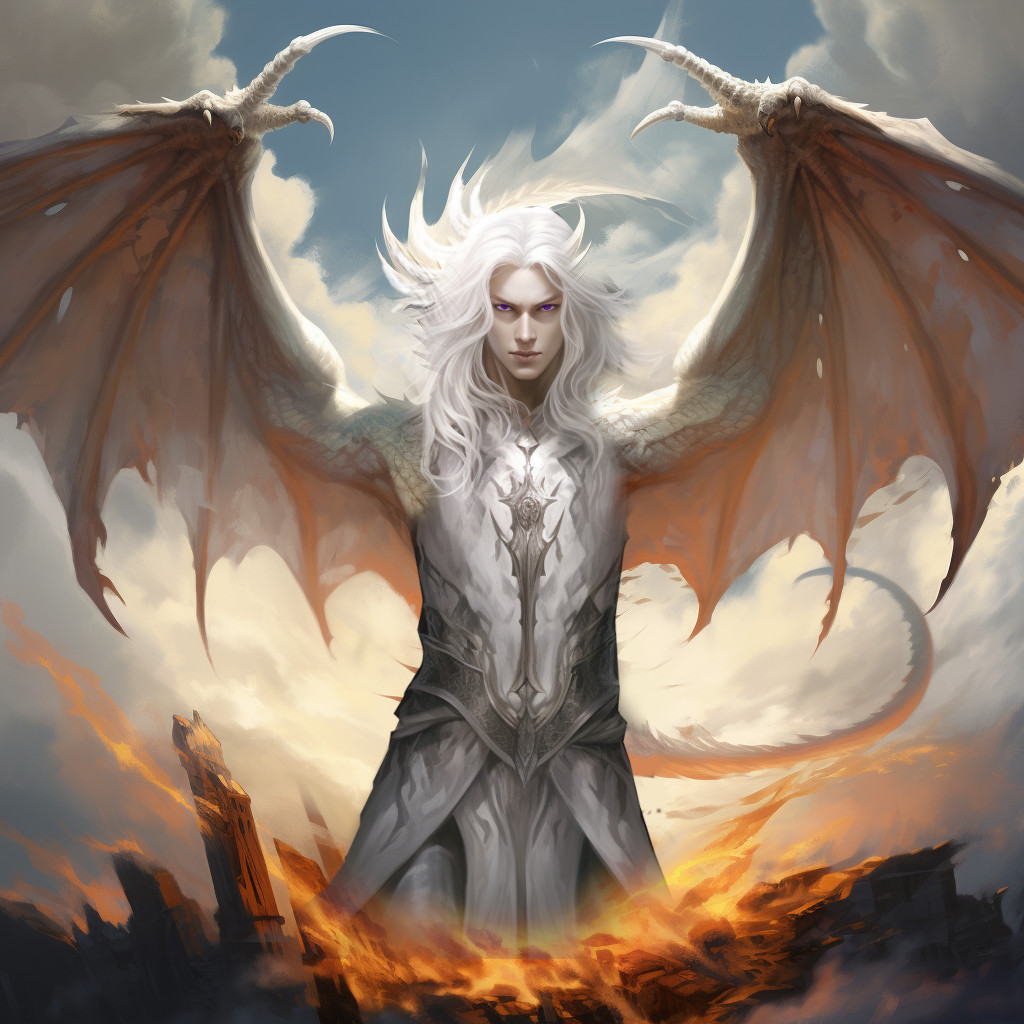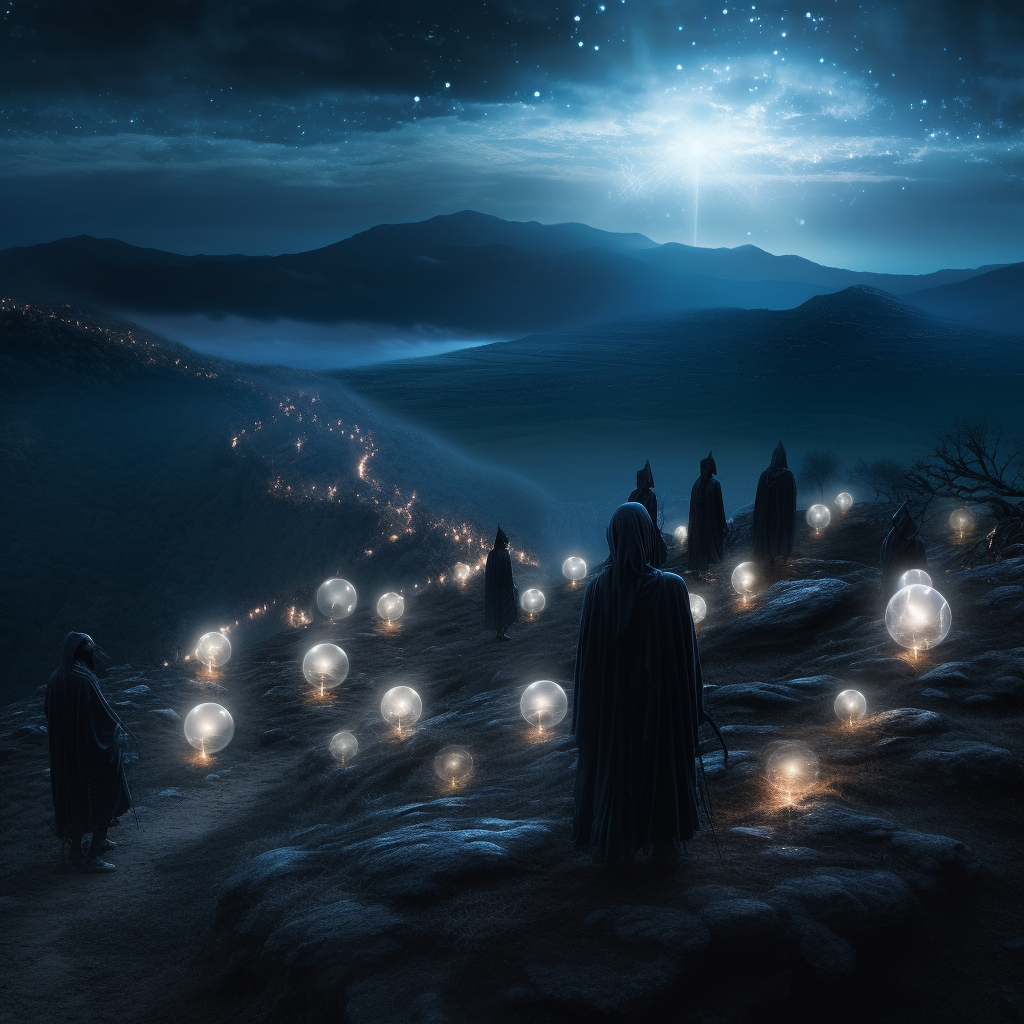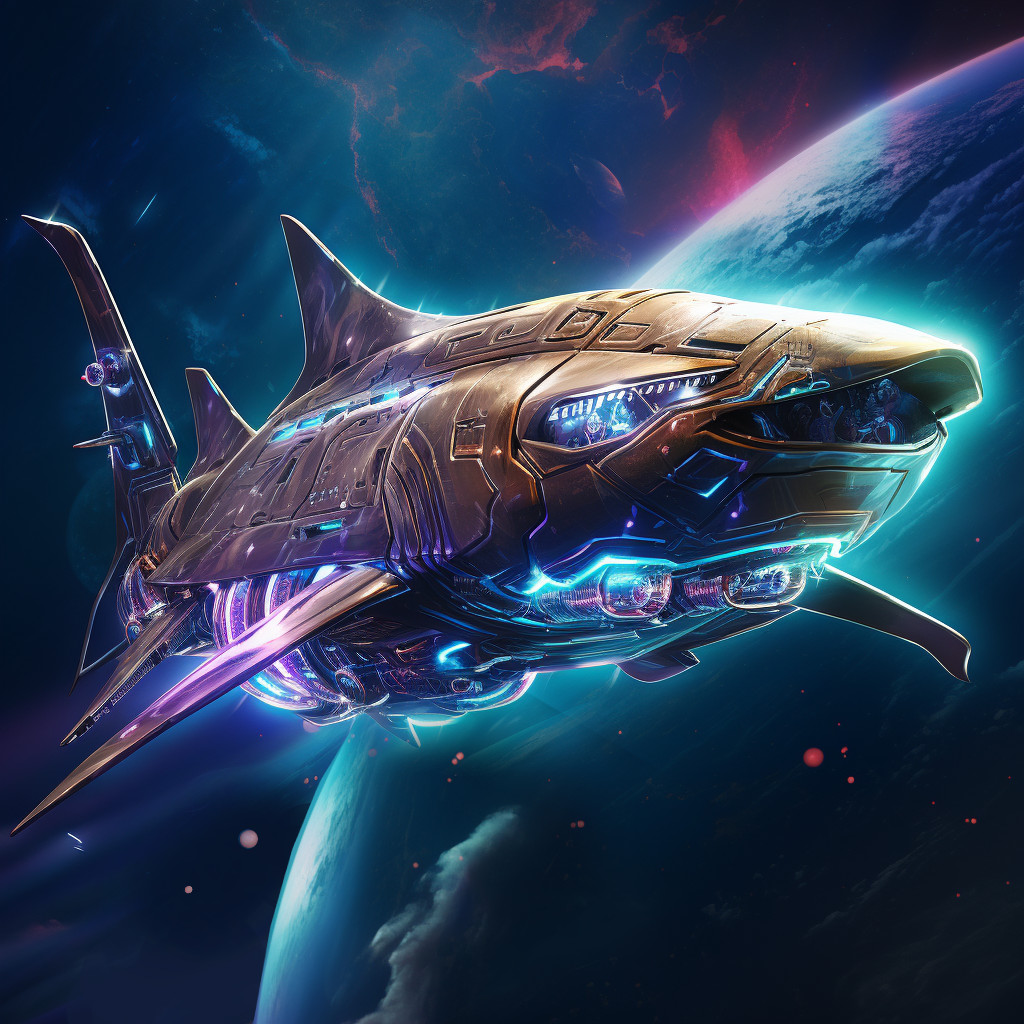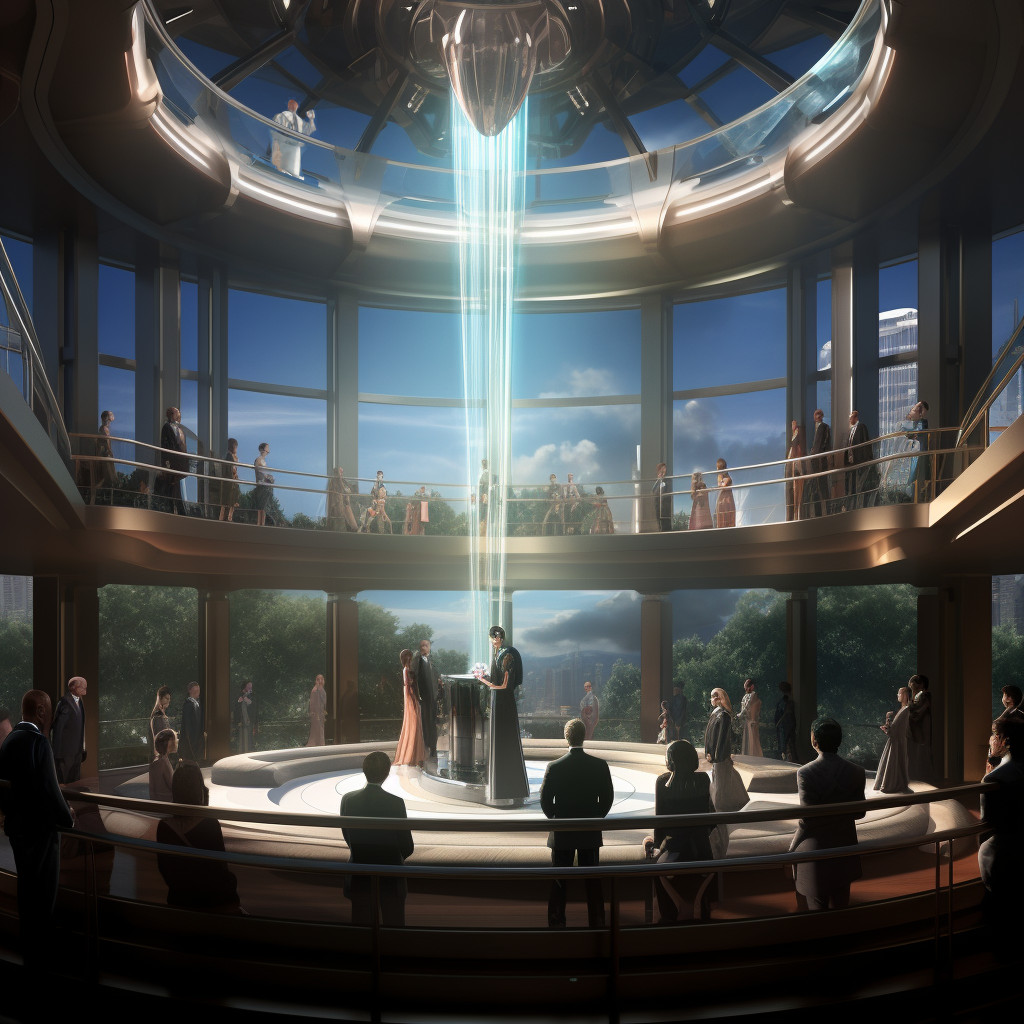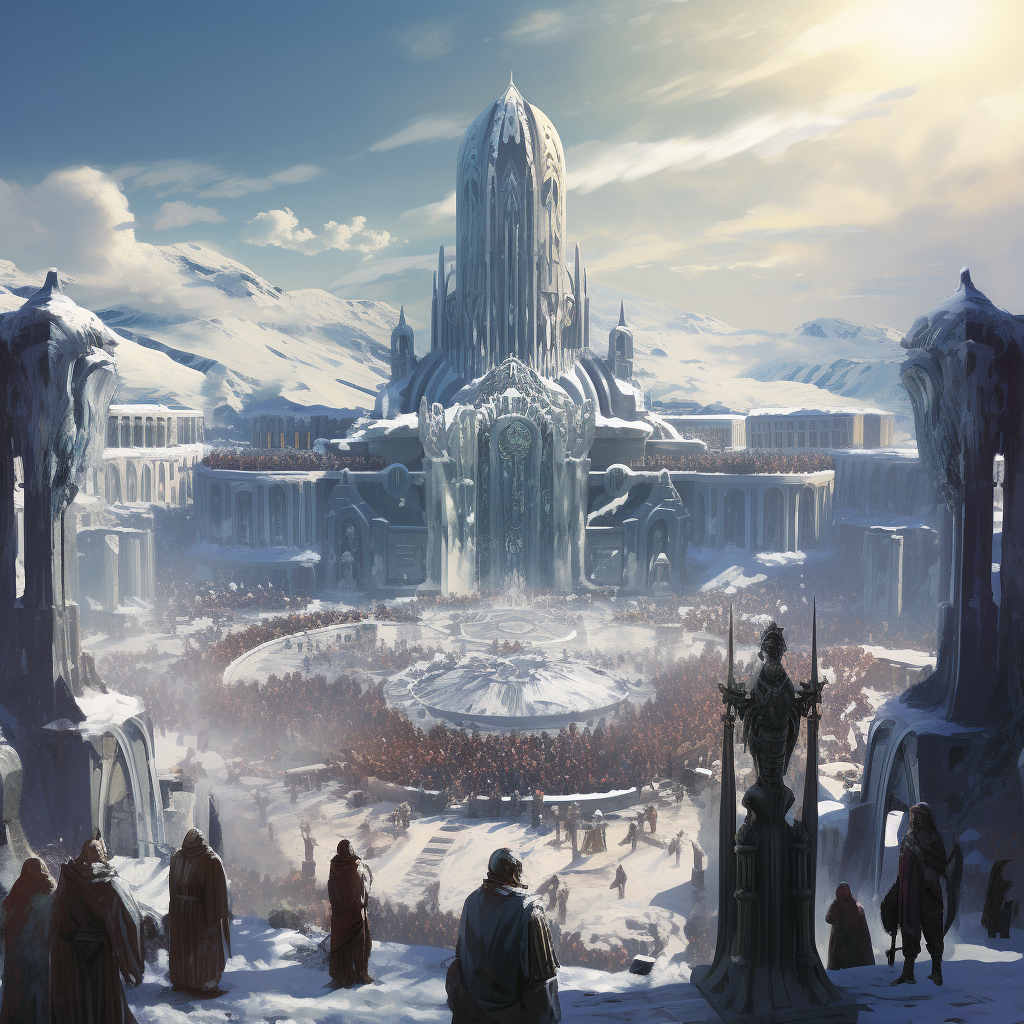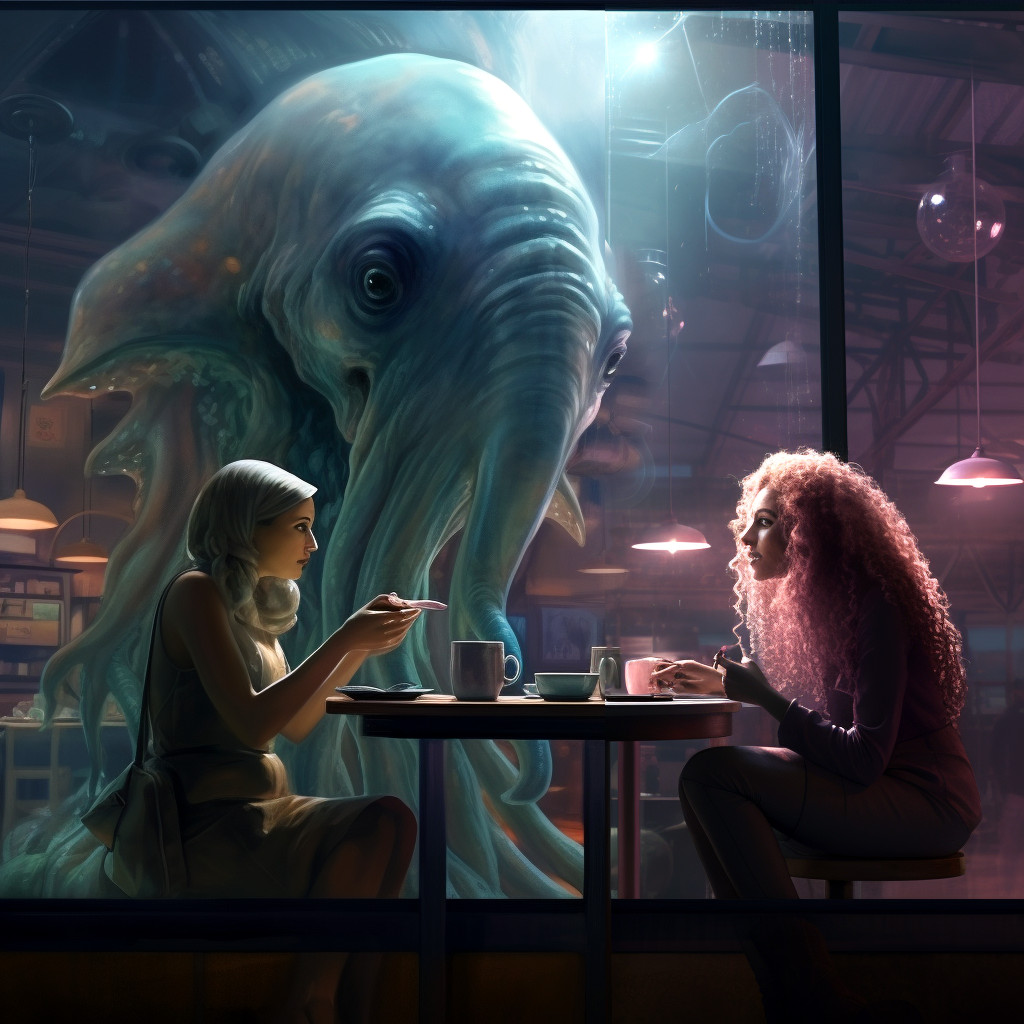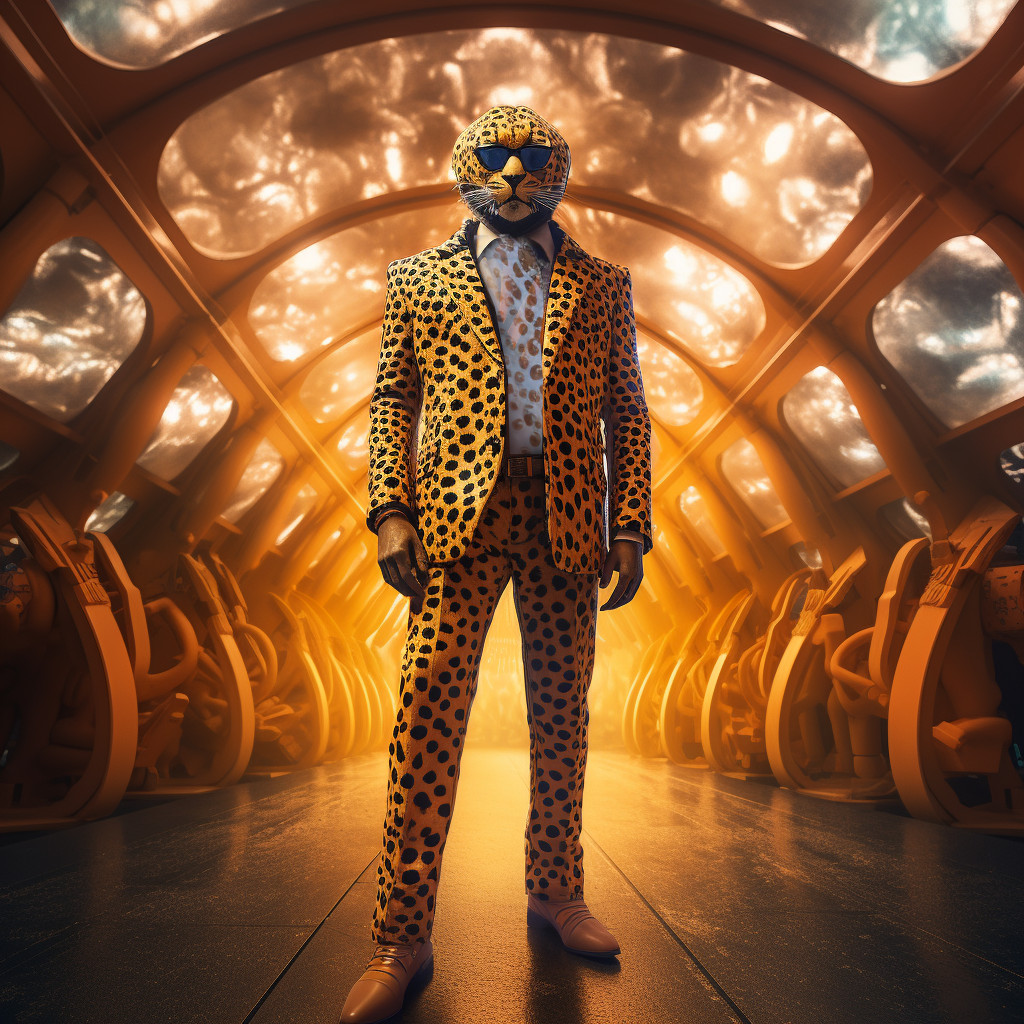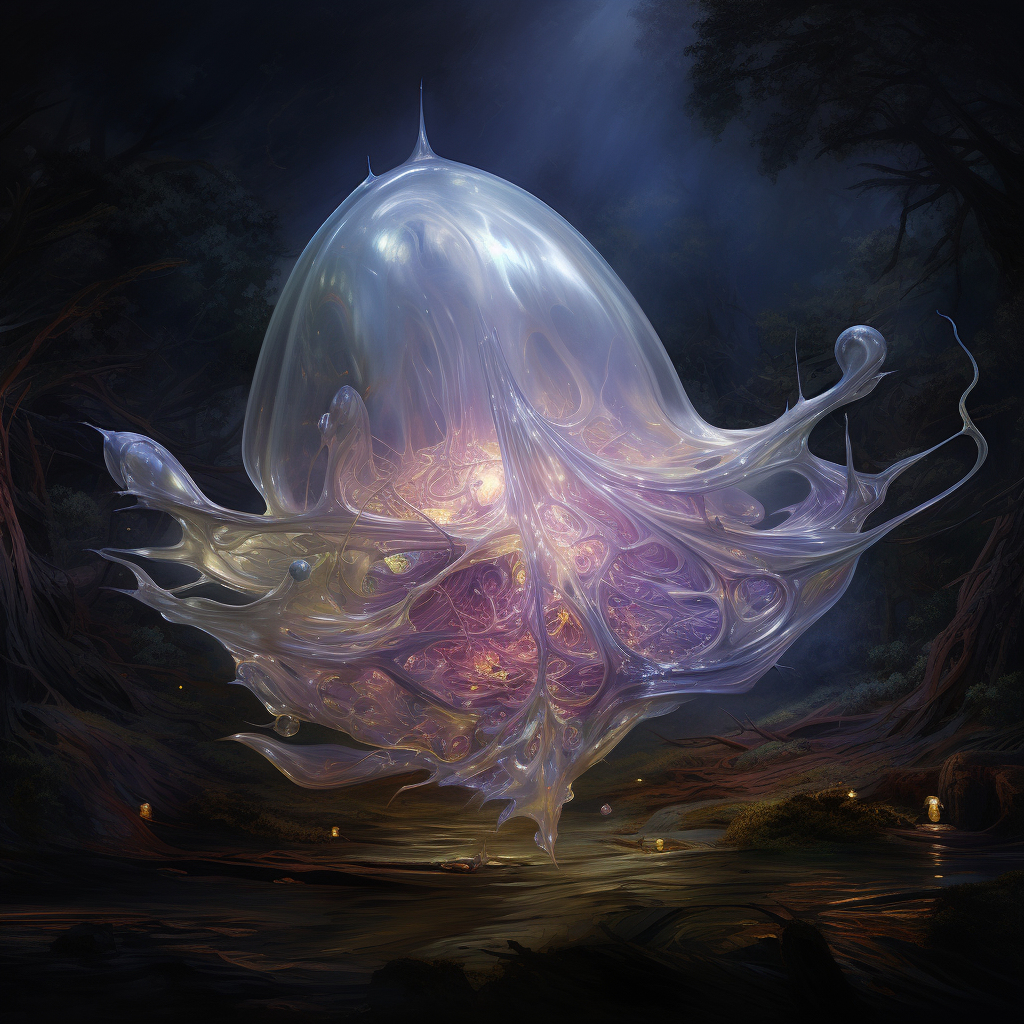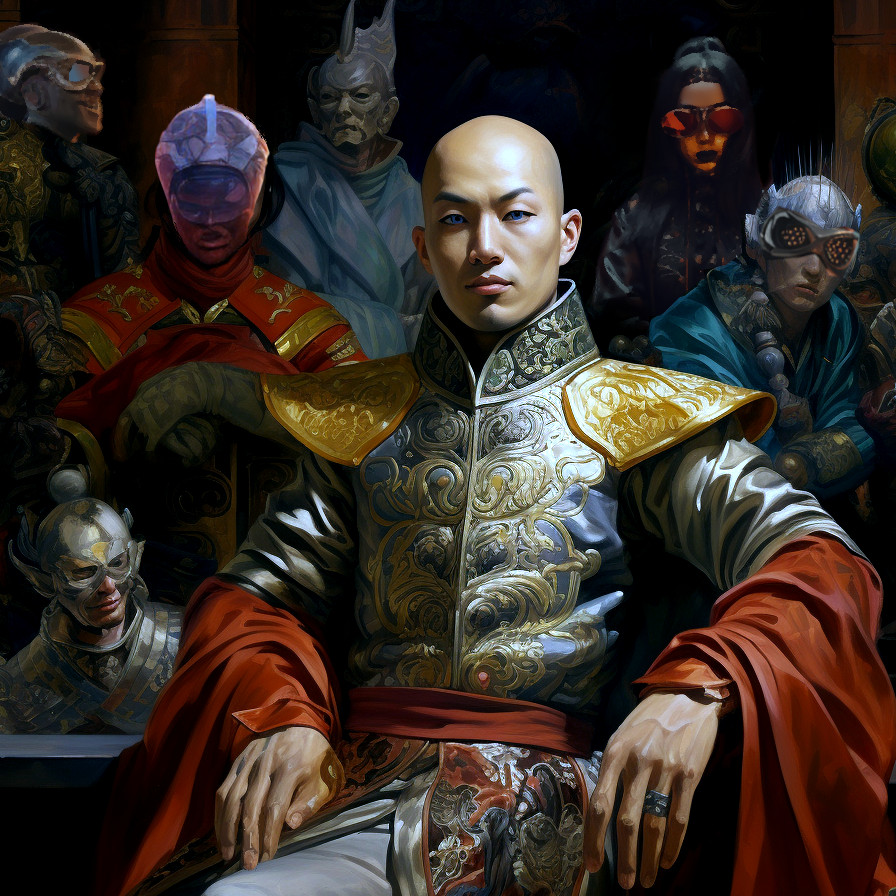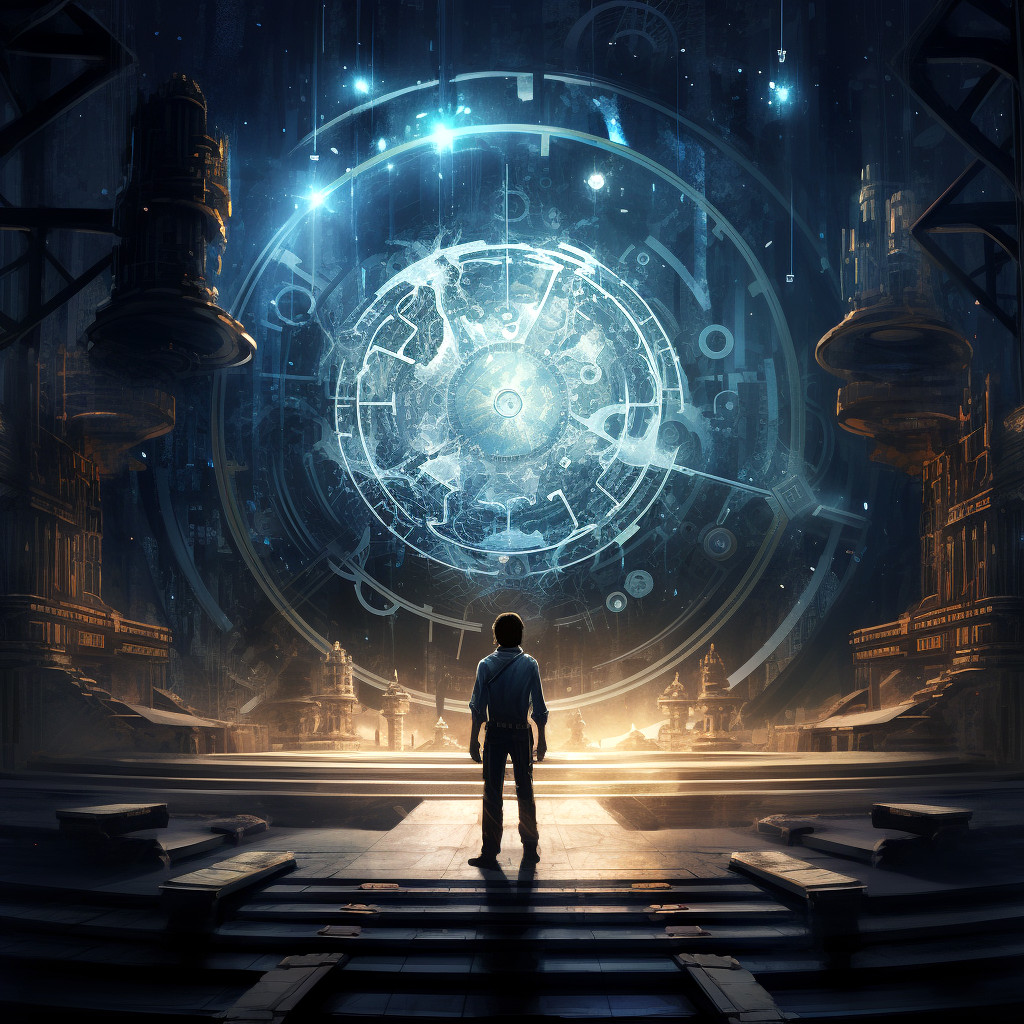Culture of the Galactic Empire of the Common Mind | |
Roots | |
The Empire's logo. |
The Empire was founded by Attequol, a mindsea who forged three thousand ten planets into a union, using the superior technology he had developed, as well as his unwavering determination and force of will. The culture of the Empire in its infancy was largely a product of his vision. The chessboard base of the Imperial logo symbolizes Patternistics. The development of this field has permitted imperial scientists to dismantle and redesign space and time to their specifications, supporting a galactic infrastructure. The globe at the top signifies a mind containing the galaxy. The term Common Mind describes the oneness in identity that the founder envisioned for his Empire. According to his plan, the empire always would be headed by a mindsea, someone able to act on Deep patternistic levels where world-lines and identities fuse. The mindsea would personify the empire and provide a unified timeline for historical events. In practice, small-minded people often seized the throne to the empire's detriment, or supported rival mindseas, and history became shredded. Over the millennia the people of the Empire went through many changes, but parts of Attequol's legacy remained fixed throughout the Empire's history: Genetic engineering that provided citizens with "antiaging," or indefinite youth. Health care centering around chemical pools within "wonderdomes." Deep-level interstellar and intergalactic ships. Torsa Horses. A government divided into branches, with the emperor's power balanced and limited by other voices. Some emperors have tried to seize absolute power, as have some non-emperors like Imperial Major Horl or Head of the Circle Raolin, but in time the pendulum has always swung back toward center. |
Imperial Branches | |
Katora, before she was green, once hid from Quintillion in a pilots lounge. |
There are two branches of imperial government, the Palace Branch, headed by the emperor, and the Bureaucratic Branch with its Circle of Scientific Experts. At times there have been third branches, formally, as when Attequol made the Mindsea Academy his third branch at the Empire’s foundation, or less so. The Pilots Guild, with its control over interstellar shipping, has rivaled the powers of the two branches, especially during times when alternate modes of transportation were unavailable. Pilots Lounges on every planet of the empire are safe haven from mindseas, imperial troops, and planetary police. |
The Palace | |
Imperial Minors serve the Palace Branch. Red, yellow and blue were the colors of Emperor Zipo. |
The emperor or empress heads the Palace Branch of imperial government, with the imperial major as their second-in-command. Since the Decadent Epoch, the power of the major has equaled or exceeded that of the emperor. Since the Decadent Epoch, the third highest official in the Palace Branch has been the mind-river of Lal. Major and mind-river have the authority to command the imperial armed forces, while the emperor does not unless standing before the Judgment Wall. Imperial armed forces are made up of imperial minors, men and women bred and trained for the job, their breeding, education, and justice system separate from that of other citizens. They are a separate race, descended from the yellow children of Ulona. While on duty, they always appear in golden armor, with or without visible weapon systems. Golden visors shield their faces. They wear plumed helmets and long surcoats with the emperor's colors and insignia. They strive to serve the Empire, though not the emperor personally. They are headed by a tradition master anonymous to the public. Planetary police forces and sector space fleets are made up of ordinary citizens. |
The Bureau | |
A session of the Circle of Experts. |
The Circle of Experts has ever rivaled the emperor in their power and prestige, controlling glowworm tentacles that permeate the fabric of imperial society to direct every aspect of a citizen's life with multitudinous regulations. The pink torus-shaped Bureau Headquarters rising against the backdrop of towers and sky-bridges of Tetbo, the imperial capital, is for many citizens the symbol of reason and civilization, the champion of citizens' rights against the irrational fury and power which the mindsea-emperors are regarded as epitomizing. |
Imperial Jobs | |
Education | |
Bioids instruct young children. |
Every adult citizen of the Empire is expected to fulfull a role in the ongoing task of perfecting of human civilization, and imperial education is designed to shape them for this role. Immediately after hatching, imperial children are gathered into creches with their age-mates, and instruction is provided by bioids in human or animal form. Parents are expected to visit often, but children live in a learning habitat with their creche-mates, unless the parents secure special designation as child-caring authorities, or if their habitat is too distant from centers of civilization to make a creche practicable. When they reach the Minimum Age of Adult Citizenship at twenty years of age, children can decide whether to immediately apply for a niche, or whether to continue their education. When they reach a hundred years of age—or a few years more or less if their creche is graduating together—every citizen must be niched. Those incapable of holding a job will be sent for wonderdome adjustment. If that fails, they may be judged incompetent and terminated. |
Job Fairs | |
The Job Fair is a city. |
Upon graduating, a young citizen will be directed to a job fair, a permanent city housing representatives of every known occupation. Graduates are expected to seek out representatives according to their diploma, which is a key that opens the portals to a building showcasing the opportunities in their niche. Once inside, the graduate will choose an opening and receive their assignment. Niches can also be assigned directly by corporate officials or government authorities if the graduate has the right connections. |
Horse Races | |
High stakes races take riders through dangerous alien worlds. |
There is an ancient tradition for some government posts, such as mayors of large communities, lunar or planetary potentates, and, on occasion, the imperial throne itself, to be won in a Torsa horse race through dangerous, Deep-level obstacles. |
Genetic Engineering | |
Thermeon's children inherited luminescent hair. |
The genome of imperial citizens has been carefully modified to produce healthy and intelligent citizens, while at the same time allowing for ample genetic diversity. The height and weight of citizens falls between officially set parameters. Although characteristics of all known human strains from pre-Dispersal times are included in the genome, making the typical imperial citizen what would be called multiracial on ancient Earth, hair, eye, and skin color determinants have been moved to mutually exclusive alleles so that contrasting colors will continue to emerge rather than blending together. Skin tones range from the palest pink to the deepest brown, with bronze, copper and gold tones as well. Green skin is caused by photosynthesizing endosymbionts, and blue skin by a variant in blood chemistry which has no deleterious effects. The silver-black and silver-white skin tones are caused by the production of reflective nodules in the epidermis, which helps to protect against harmful radiation. Aside from the pruning of genetic combinations known to cause neurological disorders, Genetic Algorithms has done little to regulate the mental functioning of citizens, as Proposals for such changes have proved too controversial to implement. Citizens who have non-human parents may exhibit non-standard features, such as the luminescent white hair of nurrs characteristic of Thermeon's descendants. |
Gender in the Empire | |
Citizens are encouraged to sample life in both genders. |
Because imperial children can be created from gene specs and grown to viability in incubators, sexual reproduction is unnecessary. However, male and female genders have been retained as part of the human heritage and species identity. Citizens may acquire a neuter identity or dual-sex identity if they so desire, but the vast majority enjoy the drama of sexual interaction, just as did their Earthborn ancestors. Bisexuality is considered the norm, as it offers the most opportunities for enjoyment. Citizens are also encouraged to experiment by switching genders during their formative years, as a simple wonderdome float will reshape their body into the opposite sex. Upon reaching maturity, many citizens feel satisfied with a single gender and sexual orientation, while others continue to switch. Until such time as they are granted reproductive rights, imperial citizens are infertile. Males do not produce viable sperm. Females do no ovulate, nor do they experience menstruation. When a citizen wins reproductive rights, the Genetic Algorithms official who hands out the incubator for their offspring will also send a signal their body switching on their ability to engender the child. Many couples enjoy natural fertilization, though it is not necessary. When it is chosen, the zygote is generally transferred to the incubator after a few days. There are of course known ways to illegally overcome infertility. Kid kits can be purchased almost anywhere in the Empire. Mindseas can use the multiple aspects of their Deep-level selves to make themselves fertile, as can Deep-level pilots who minutely guide their upleveling. |
Children of the Empire | |
Mating Flights | |
Reproductive rights are awarded to the winners of mating flights. |
During the Decadent Epoch, many children born in the Empire were the result of mating flight hookups. The parents had probably never met before the race and probably would not meet again afterward. Terms set out in the mating flight advertisement specified which party would be responsible for raising the child. The Department of Genetic Algorithms would naturally not approve production of a child without provision being made for its care. The parents could, if they wished, specify some third party as caretaker. It was fashionable for wealthy citizens to have their children raised at the Orphan School of Mosalno. They would first introduce themselves to their offspring at their MAAC graduation, when the child was twenty imperial years of age. |
Marriage | |
In the Contested Era it became common for two parents to raise their child. |
Marriage was outlawed during the Decadent Epoch with the reasoning that it restricted genetic variation. After Thermeon's accession, such long-lasting bonds were once again allowed. It became common for children to be raised by both of their parents, and for Genetic Algorithms to grant reproductive rights to the same couple multiple times. The right of lovers to send forth their genes overrode the genetic diversity argument. The number of citizens able to reproduce has varied from era to era. During times of expansion and settlement of new planets an increased birth-rate has been permitted, but throughout most of the Empire's history, privileged couples have produced children with gaps of only a few years space between them, while those without swift steeds for mating flights may wait in vain for centuries. |
Group Marriage and Mixed Marriage | |
More than two parents may contribute genes for a child. |
Another reproductive strategy that has varied in popularity across the millennia is the Group Marriage, where more than two people contribute genes to the child. At one time group marriages involving up to nine people were not uncommon. This allowed citizens to have children, even if they were unable to win a mating flight. Occasionally citizens of the Empire have requested reproductive rights with aliens, with zombies, with members of other species, or even with bioids (artificial life-forms). Such children are produced with the aid of gene-splicing laboratories. Parthenogenesis is another reproductive mode which has waxed and waned in popularity. During most periods it has been considered selfish, and it has sometimes been outlawed. |
Birth | |
Almost all imperial children emerge from incubators. |
Nearly all citizens are birthed or "hatched" from incubators provided by Genetic Algorithms to those who have won reproductive rights. The emerging infant is more developed than ancestrally birthed babies were. Within days they are walking and talking. Rarely, a citizen will opt to experience childbirth in the ancestral mammalian way. Men and women alike can be altered to undergo this experience. Some of the poorer native peoples of the Empire, including Lalian peasants, undergo childbirth as a rule, although they rarely acquire reproductive rights. The Nanders also birth their young in the ancestral manner. Oviparity has sometimes been a fad among imperial elite, and bodies adjusted to produce eggs. |
Names | |
Citizens celebrate attaining their MAAC. |
All children born to the Empire are issued names by Genetic Algorithms. Letters of the name correspond to the recipient's genome. Sometimes the combination of letters has unfortunate results. If the recipient or the parents are unhappy, they can pay to have the name changed. The cost of a name change increases exponentially with each additional letter to be changed. Deleting a letter costs double. Granting name-changes is Genetic Algorithms' major source of income aside from accepting bribes to grant reproductive rights. Many people, unable to afford a name-change, must satisfy themselves by using a short version of their name or a nickname. Some people, like Thermeon and Quintillion, name themselves. All citizens are assigned three names. Full siblings will receive the same third name. At times it has been the custom for citizens to switch between using their first and second name when they switch sex. Because of the vastness of the Empire and the complexity of its systems, the imperial age of majority is a hundred years; however, starting at twenty years old, the Minimum Age of Adult Citizenship, children enter a series of subadult stages with increasing responsibilities that lead gradually to full adult status with its priviliges. |
Generations in an Ageless Society | |
Empress Auskirk distinguished herself with a live flower in her hair. |
Thanks to antiaging genes, a citizen's age is not revealed by their appearance. Nevertheless, most citizens feel that their particular age-bracket is superior to others, and make their allegiance known by their dress, hairstyling, and speech mannerisms. Glowworm-animated clothing and hairstyles have been known back at least as far as the the Founding, so creating a new, shocking style is not easy. Yet every generation attempts to make its own unique statement. Sometimes a style from an obscure planetary tradition, which may have been considered provincial the year before, can be elevated to the year's "in" thing. The resh-wool ponchos of Longgorians, and even Nander pajamas have had their day. From time to time, it has become popular with the young crowd to augment their bodies with animal features, such as wings, fur, or tails. Those who do are known as animal-heads. |
Animal-Heads | |
Citizens who changed their form but not their genome were called animal-heads. |
Early during the Contested Era, it became the fashion for the idle youth of the Imperial capital Tetbo to transmogrify themselves with animal features. These animal-heads filled the nightspots along the Way, the central thoroughfare of the capital, indulging in all-night dancing and debauchery. Animal-heads believed that an Age of Falling Darkness, brought about by the excessive use of Deep-level equipment in the Empire, was about to engulf the galaxy. The Empire's leaders would be unable to divert this disaster. Holes had been rent in the fabric of spacetime, and Deep-level material was bubbling through these tears into Shallow levels, taking the universe's energy along with it. Entropy would gobble up the exhausted universe. The lights of the stars would fade within a few years, leaving the galaxy cold and black and dead. The animal-heads wanted to enjoy themselves while they still could. Quintillion claimed that the animal-heads were followers of Thermeon, imitating his animal features. Some pundits believed that they modeled themselves after Quintillion's imperial major, River Rock. Still others say that the animal-heads' leader was Torm, a stepson of Quintillion who fought his father for the throne. |
The Five-Generation Rule | |
Katora claimed descent from Empress Besi. |
Because it is possible for citizens to live for thousands of years and to continue winning mating flights throughout that time, and for their children and children's children also to win mating flights, the Empire's oldest citizens may live to see thousands of descendants. At a time when heads of both Imperial Branches—Emperor Thermeon and Head of the Circle Raolin—were prolific breeders, the Five-generation Rule became law. Accordingly, no citizen may claim kinship with a progenitor more than five generations removed. This relieves the elder citizen both from inheritance claims by the youngster, and from criticism should they unwittingly—or not—mate with their own distant descendants. A citizen may still claim descent from a celebrated ancestor, as Katora cites her connection to Empress Besi across eighteen generations, but such ties have no legal significance. |
Classes in the Empire | |
Height is a sign of social status. |
Officially, there are no classes in the Empire; every citizen is equal before the law and all will receive an exhaustive education and find opportunities for obtaining reproductive rights. In practice, the descendants of the people who came with Attequol when he conquered the planets occupy the best niches and dominate mating flights. As they have tweaked their genes to maximize their height, these aristocrats are almost always much taller than descendants of a planet's conquered native peoples. Mindsize is another source of division among people. During times when mindseas have been admired or even worshiped, those who could boast of mindpowers rose to the top of society. During periods in which mindseas were villified as subhuman, those suspected of mindpowers suffered various persecutions. |
Death in the Empire | |
Common Causes | |
The crystalloid doesn't realize anything is wrong. |
The most common cause of death in the Empire is mental shutdown, or crystallization. The second leading cause of death is suicide. Accidents rarely prove fatal, thanks to the twin safety nets of wonderdomes and copy insurance. Disase organisms and genetic weaknesses have been weeded out through the efforts of Genetic Algorithms. Local natural disasters are held in check by weather engineering. A small number of fatalities, including unexplained disappearances, occur because of criminal activity or malfunctions in downleveling equipment or spatiotemporal-translation equipment. |
Megadeath | |
Thermeon's Deep-level rages were deadly. |
At times plagues have broken out among strains of glowworms to attack human bodies from the inside, causing great loss of life. Warfare involving Deep-level weapons or bio-engineered weapons has also caused heavy losses. Rampages of the most powerful mindseas have unleashed destructive Home-level and Deep-level phenomena on a planetary scale. |
After Death | |
Mourning rites don't involve the body. |
When a citizen dies, the body is usually disposed of without ceremony. Every wonderdome is equipped with one chute leading to the float tanks, and another leading to the recycle unit. Certain religious movements claim that this is callous behavior typical of the Decadent Epoch, but even for believers, death is seldom marked by any ritual beyond a ceremony of remembrance, which does not require the presence of a corpse, which, because of their unfamiliarity with death, might traumatize citizens. Occasionally, especially on obscure planets, the gene specs of the deceased may be deemed so valuable that they are preserved, sometimes along with the body itself. The body may be reanimated with glowworms, becoming a "zombie" rather than a citizen, as the individual's personality has been lost. |
Crime and Punishment in the Empire | |
Crime | |
Planets panicked when the dreaded shark ship of Zap the Pirate appeared. |
Across the ages, perhaps no subject has seen more debate within the Circle of Experts than the crime question. It has been argued that Genetic Algorithms has the means of rendering all citizens happy and law abiding, so why shouldn't it be done? Opponents of the "Perfect Humanity" cause argue that such perfect humans would have been robbed of their self-determination, a quality more vital than security or predictability. Also the concept of what is lawful can evolve. Thus far, the "Determine" cause has won out in the Empire, although other sovereign states within the galaxy are thought to have honed their citizens before succumbing to outside invaders. The most common crimes within the Empire are burglary and cheating in games of chance. Smuggling and the selling of unauthorized or falsely advertised substances are common as well. There are numerous illegal practices centering around hard-to-obtain reproductive rights, from the selling of incubators, to gene theft, gene substitution, and incubator theft. Serious crimes such as rape and murder are rare. Citizens, especially those living on less prominent planets or in transit through the galaxy, may be subject to attack by slavers and space-raiders, although members of these criminal organizations are often not imperial citizens themselves |
Trial and Judgment | |
The judge observes from Contamination distance away as witness testimony is analyzed for truth. |
Citizens suspected of criminal actvity are taken into custody by planetary police or imperial minors after having been caught in the act or accused by a victim. The suspect is tried in a court of law where evidence can be presented by lawyers or other interested parties. A judge rules on the guilt or innocence of the accused and decides on punishment. Punishment usually consists of a wonderdome float designed to correct the psychological imbalances that caused criminal behavior. If monetary harm was caused to other citizens, a fine must be paid to compensate them. If public harm was caused, the crimial may be required to perform community service. There are no prisons, per se, although a repeated offender may be sent to facilities such as the one on Wikow, where experimental forms of correction will be attempted. If the judge rules that a suspect's accuser has presented false evidence, they will be sent for correction instead of the one they accused. During the Contested Era, trial by mindsea was invoked for notorious cases. The accused would be brought before the mindsea to have their thoughts reamed for guilt or innocence. If they were found guilty, the mindsea would instantly put them to death with a mind-blow. Thermeon, Maxuas, and the Torms took part in this practice, but Quintillion did not. Aside from acts of treason and rebellion, few crimes merit the death penalty. Since the year 92,146 misuse of mindpowers has been a capital crime. This is considered just because mindseas can manipulate court evidence to exonerate themselves, because they are impervious to any form of correction, and because the harm they can cause in psychic pain and physical damage is beyond measurement. |
Art and Drama | |
The human element in art gives it meaning. |
Self-programming bioids can be designed to replicate all the fine arts humans have created on Earth and beyond, as well as designing never-before-seen art forms. However, imperial society has always regarded art produced by a living mind as having more intrinsic value than anything spun out by a bioid. Empress Besi's pronouncement that "the living mind stirs the Deep but a mechanism without self-will cannot," continues to hold sway. Therefore, works of art produced by citizens (with or without bioid assistance) are clearly marked as meaningful and presented for public enjoyment and critics' dissection. In the same way, although bioids can produce a believable (to the Deep-blind) imitation of any human emotion, humans who perform in live theater are accorded the laurels of audience appreciation. Scenes in which characters perform beyond-human acrobatics or suffer dismemberment or explosive death are of course portrayed by bioids. |
Sport | |
Zero-G ballgames are popular. |
As art is regarded as an important human endeavor, so too is sport. Genetic Algorithms could engineer men and women capable of superhuman feats, but this has never been acceptable to the Common Mind. The standard human model, with its strict limits as to size and structure, is zealously maintained for all citizens, including athletes. Because of this, the champion's fans can thrill to the knowledge that only a concentrated effort of will and rigorous training resulted in their winning performance. There have always been those who attempt to illegally augment themselves, but when caught, they are subjected to public scorn as well as trial and punishment. Popular sports include sword-dancing, falconry, wrestling, snow, ice, and water games, as well as many forms of ball games originating on different planets. Mindseas are not permitted to compete in athletic events, as they would have an unfair advantage. |
Torsa Horses | |
Torsa horses emerge from the Plains of Possibility. |
Since the legend of Kokkiro riding the white horse up the Stairway of Ice is known to every imperial world, Deep-level horse-like beings known as Torsa have been cherished throughout the Empire from its earliest history. After the reign of Attequol's son Aturon, it became the custom for the Emperor to ride a white stallion, said to be the same one ridden by Kokkiro, up the main thoroughfare of the galactic capital. In theory, every citizen is entitled to their own Torsa. But in practice, only the wealthy and connected can afford to take their children to an intersection with the deep-level homeland of the Torsa—the Plains of Possibility—for bonding to take place. Once human and Torsa have bonded, the pair can participate in races sanctioned by Genetic Algorithms as mating flights, or by planetary governments as races for office. Deep-level horseracing was known to the earliest imperial eras and experienced a resurgence during the Age of Illumination, with many new tracks being built. The greatest of these was Racetrack of Bri, built by Shell. Once they charged from the starting gate, horses and riders would find themselves transported across world-lines into different times and places, perhaps into unknown dimensions where laws of physics changed unexpectedly. Many adventures had to be faced before the racers could reach the elusive finish line. It is a sport for the courageous or foolhardy. At times during the Empire's history, there have been Ultima Derbies, for which each planet tries to field a team of horses and riders wearing their planetary colors. They are allowed a personal choice of hats. |
Religion | |
The Festival of Suffering on Yohorb. |
The Empire has no offical religion. It is the stated position of the Bureau that science, especially the study of Patternistics, represents the most accurate explanation of reality the human mind can encompass. However, many citizens adhere to the faiths of their ancestors or their planets. The Code religion has the most numerous and active following. They believe the genetic code to be a message from a loving goddess who has been guiding life, ever since the beginning of creation, toward fulfillment within her transcendant awareness. One branch of the Coders believes that Maxuas was the Goddess's chosen representative in the Milky Way Galaxy. They regard all of his descendants as holy. Many of the poorer citizens of obscure worlds, deprived of their ancestral faiths with their world's conquest and inclusion in the Empire, worship their conqueror, Attequol, as a god who continues to express his will through the Judgment Wall in Lal. The worship of Kokkiro is also prevalent throughout the galaxy. Believers know that he awaits them at the top of the Stairway of Ice, in the center of space and time, and expect to join him there after death. The Nanders hold to their primieval faith. The first man, Salomano, sacrificed himself to give them eyes. When they saw through his eyes, they learned to sing and dance, and became human. They reenact his sactifice in their Grandmother Damce. Mindseas have frequently introduced religions that centered on themselves as primary deity, only to have those religions fade after their demise. Horl invented a religion called "Faith, Love, and the Greater Good" in order to excuse the blood sacrifice he required to produce soul-gems, and it lasted beyond his overthrow through the enthusiasm of its chief priest, his granddaughter Zilf. |
Language | |
Children are tutored by bioid pets. |
Lalese is the official language of the Empire. Although children of many native groups learn to speak a planetary language from their parents, Lalese is part of their required education. It is used exclusively in interplanetary circles and by planetary governments. Sophisticates usually consider use of one's planetary lingo a mark of poor upbringing or peasant mentality, although at times novelty seekers have made obscure languages, even non-human languages, a fad. Even so, the speakers of the rarest language cannot hope to confound eavesdroppers. A citizen's standard internal has the capacity for interpreting all known forms of communication in a way that makes understanding seem instantaneous, so a citizen needs to be extremely innovative if they want to have a private conversation. Every child is taught to speak Lalese by bioids whose programming has not been changed for millennia, so there is very little evolution in ordinary speech. But each generation strives to find some special lingo of their own, usually based on references to events or personalities that were famous during their youth. Use of such phrases, as well as style of dress, identify a citizen with his or her era. Dressing or speaking as if from an era other than one's own is considered rude, even bordering on criminal. |
Non-Citizens | |
Other Species | |
Any being who can pass the Alien Sentience Test may become a citizen. |
Within the galaxy there are countless plant, animal and alien life-forms, as well as persons of human stock who originate from non-imperial worlds. Any species, even descendants of animal species spread from Earth during the Dispersal, can gain the status of alien sentient by passing the Alien Sentience Test. Any being passing this test may apply for and receive citizenship. Those not wishing citizenship are still protected by "Friendly Alien" laws, which have varied from millennium to millennium. A movement known as Greenism strives to outlaw the killing of any life form. Greenism proposes that every citizen be provided with photosynthetic endosymbionts, making the need for plant and animal foods obsolete. A more popular alternative to the slaughter or animals and harvesting of plants for food is the production of tasty, nutritionally balanced artificial meat, vegetables, and fruit. |
Slaves | |
Ix wore boots that struck the floor with thunder, emphasizing her power. |
At various times during the Empire's history, most recently during the Decadent Epoch, human slavery has been allowed, supported by arguments that some humans are too stupid, lazy, or overwhelmed by the vast complexity of imperial life to care for themselves. Although all slaves were freed after Thermeon's accession, humans can still opt to give up their citizenship and live as total dependents, as long as they are willing to adopt an animal morph that clearly states their status. Illegal slavery persists, despite numerous government attempts to hunt down slavers. For millennia after the abolition of human slavery, a daughter of Horl named Ix ruled a vast slaver empire and called herself "Empress of the Unknown." She kidnapped citizens, wiped their memories, and sold them to the highest bidder. |
Pets | |
Some citizens make their living by dressing as animals and playing the role of pets. |
Despite the number of non-human species in the galaxy, pets are uncommon in the Empire. Bioids fashioned to resemble animals have long since taken their place. On some planets it is popular among the wealthy to engage poorer humans to dress up like or morph themselves into animals for the amusement of their children. Such hirelings are known as ersatz beasts. |
Nanders | |
Nanders enjoy their ancestral way of life. |
Since the Decadent Epoch, there have been spread throughout the Empire small populations of a people known as Nanders, who do not share in the culture of the Empire. Their genes have not been altered from ancestral stock; they have neither the varieties of colors of citizens nor antiaging. During the Decadent Epoch imperial citizens regarded Nanders as little more than animals. Aristocrats hunted them from air lifters. Others were put into slavery, along with humans and aliens. Nander slavery and Nander hunting have been outlawed; however, attempts to make Nanders full citizens are strongly resisted, both by citizen groups and by the Nanders themselves. Quintillion, part Nander himself, tried to overcome this resistance. He instituted numerous projects to make the Nanders integral to the Empire—as mind-rivers, interstellar pilots, or trans-gate operators—without lasting success. |
Deep-level Beings | |
Aigglet, offspring of the Aiggle, was not as deadly as its parent. |
The universe of spacetime in which humans have evolved is known as "Home Level", and is distinguished from deeper or shallower patternistic levels by its "number-of-divisions" or the graininess of its basic units. The deeper the level, the more discontinuous reality becomes. There are species that have evolved for deeper or shallower levels than the human Home Level, but because of differing perceptions, not the least of which is time perception, humans have rarely had contact with such species. Exceptions are the Torsa Horses, the zills of Wamatu, and the whales of Medne. On other rare occasions humans themselves have adapted to deep-level life. Once instance of this took place on pre-Imperial Mars. Mindseas do of course venture into deeper levels when they exercise their powers. Some of the Empire's technology, such as tetrascoping ships and farfling towers also impinge upon deeper levels. This has occasionally brought the Empire into conflict with Deep-level beings who resented the incursion into their territory. Conflict has resulted, such as the strife with the Aiggle in 104,822. |
Mindseas | |
Definitions | |
Masked supplicants in the presence of Emperor Zipo. |
A person who possesses mindpowers, or the ability to act on Deep patternistic levels, is called a mindsea if their mindpowers are of a certain type. According to the official definition, a mindsea has the ability to link telepathically to anyone they know. They cannot link to people they have never met, nor can they "overhear" the thoughts of people with whom they are not linked. Historians feel that citizens did not hate and fear Attequol or his successors, and it was not until after Rathax that mindseas earned a reputation for menace. In order to protect citizens from the powers that mindseas wield over lesser minds, the Contamination Laws were enacted toward the end of the second Plutocratic Era by Empress Hosto. Contamination laws are also known as "ritual separation," especially when enforced for emperors who are not mindseas. They prescribe the distance that must be maintained between the mindsea and unmasked citizens for them to remain safe. An alternate mode of enforcing ritual separation is the use of protective barriers or full body armor including masks or visors. The assumptions behind the Contamination Laws are that mindseas can only exert their powers on individuals known to them, and that proximity is the only way that they can come to know an individual. Whether those assumptions are true or not is another matter. It is thought that the contamination distances prescribed by the laws reflect the visual acuity and verbal processing characteristics of a particular mindsea, perhaps Zipo (emperor from 37,889 to 46,000). |
Contamination Laws | |
Rainbow lights warning citizens of a mindsea's approach. |
A mindsea may not touch their bare skin to the bare skin of a citizen. A mindsea may not touch a protected citizen with more than 1.516 units of force. The mindsea must maintain a distance of 17.23 millilengths from a citizen, this distance to be known as the "Contamination Distance." The Contamination Distance is invariant under all weather conditions. When going abroad in a public place, the mindsea must give notice of their approach by warning lights and alarms. The Contamination distance on every side of the mindsea must be indicated at all times by contamination lights in a full spectrum of colors. If a mindsea is addressed by a citizen, the mindsea may not reply before the elapsing of 5.64 second pause, this time to be known as the "Contamination Time." The mindsea must observe personal cleanliness to a degree that prevents their body odor from reaching a citizen standing beyond the Contamination Distance. A mindsea may not pass or throw an object to a citizen. A mindsea may not respond to any gesture made by a citizen until after the elapsing of the Contamination Time. Violation of any of these rules constitutes the "Contamination" of the citizen. A Contaminated citizen is entitled to collect from the mindsea compensation equal to the citizen's total projected earnings during the remainder of their natural life. The Contamination Laws were rescinded at the end of the Contested Era, and were a dim memory by the time of Age of Illumination, when the number of mindseas in the Empire vastly increased. People with telepathic powers less than those of mindseas are called mind-rivers if they can link only to identical copies of themselves, or mindpools if they can link to a few people with whom they have special ties. The latter term is rarely used. After the destruction of the farfling system during the Contested Era, mind-rivers with copies placed on distant systems provided the chief conduit of interstellar communications until the temporal adjustment of the farfling towers allowed them to function once again during the dawn of the Age of Illumination. Another group of citizens who possess mindpowers, though they are rarely seen in that light, are the Empire's interstellar pilots. |
Teachings of the Mindsea Academy | |
Quintillion taught Katora in the Mini Milky Way. |
Attequol founded the Mindsea Academy to pass his knowledge of Patternistics to future generations. At times the upheavals of history have closed the academy's doors and denied knowledge seekers; but a second, secret store of records within the Imperial Museum has always allowed Attequol's teachings to be rediscovered. Among the those teachings are the Four Tenets of Patternistics: |
| |
|
Other key concepts of Patternistics include: Patternistic Integrity, the oneness of a system. It is patternistic integrity that determines the extent of a being, not the molecules making up the body. Unfusing, or destructive upleveling, takes place when entities on a Deep-level ship lose patternistic integrity.
Patternistic Equivalence is the relative position things occupy in a system. It determines the forms travelers take when they enter reenactments. The Total Configuration Effect is the conservation of pattern in the universe. As the total pattern determines every bit composing it, so every bit reflects and determines the overall pattern because it can only fit into one particular pattern. As in "To see a World in a Grain of Sand" and "Eternity in an hour" the TCE dovetails with the First and Second Tenets. The Exact Configuration Effect, meaning that subtle changes in a pattern’s tiniest bits may bring about a major change in a system, analogous to a phase change. The Approximation Effect, meaning that the pattern does not need to exactly match the previous configuration that triggered an effect, but merely be close enough. Rules of Concept Formation are thought to describe the way in which patterns of the universe change from one instant (quantum refresh event) to the next. There are four, five, or six rules depending on the source: Arbitrary, Extension, Negation, and Mixing are the most basic. | |
Mindsea Powers | |
Horl strove to master the Second Tenet. |
According to the teachings of the Mindsea Academy, application of the Tenets of Patternistics should give the practitioner the ability to do amazing things. Knowing that space is an artifact constructed from more basic constituents on deeper levels should allow them to assemble any location around themselves, and knowledge that time is fashioned in the same way should make it possible to step out of any moment in time and into any other moment. But in practice, such feats are impossible. No Academy student since the Empire's foundation has gained such abilities. According to myth, Attequol could travel through the Center to any point in spacetime, but it is only a myth. In practice, many Academy students have learned to work the Third Tenet, to experience a merging of identities with others in mind-link. Some patternists claim that all mindsea powers are based on the Fourth Tenet. According to the Fourth Tenet, all a mindsea—or any living being—can do is to choose which among many possible futures to observe, by this choice making that one possibility real. It is the same process as decoherence of a quantum superposition. In the instant between untouchable past and untouchable future, a living mind is composed of the superposition of many possible states. In the next instant, only one of those states persists, and a different superposition of possibilities occurs. What makes mindsea observations more powerful than those of most humans is the number of possibilities in superposition. The deeper the patternistic integrity, or identity-entanglement, reaches, the more possible futures can be winnowed through. That is why some patternists believe that Attequol might indeed have possessed the powers myth ascribes to him. When a mindsea chooses a future moment, no laws of physics are violated. Whatever phenomenon the choice unleashes, even a blast of destructive energy such as Thermeon directed against the planet Wamatu, will have as its proximate cause some working of known physical laws, although the chance of such an event occurring may be vanishingly small. |

